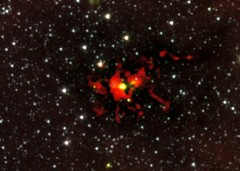Using a normal 'visible-light' telescope, we see just a tiny part of all the stuff in the Universe. To get a real picture of what the Universe has to offer, we need to look at all the different types of light coming from the sky. Radio, X-ray and infrared are examples of other types of light. They are just like normal light, except that our eyes can't see them: they are invisible to us. It's like sound: humans can’t hear sound that’s too high or low pitched (Did you know dogs can hear sounds that are too high for our ears to detect?)
Without telescopes that collect these exotic types of light, we'd never see a huge chunk of the objects we know are floating out there. The red cloud in this picture, for example, was invisible to us until an infrared telescope stumbled across it and revealed this image: a dramatic region filled with ribbons of gas and dust. After its discovery, astronomers decided to look deeper into this thick cloud by using the ALMA telescope, which collects radio waves. Little did they know that they'd uncover a true mammoth star growing inside this dusty womb!
The ‘womb’, or collapsing cloud, has over 500 times more material than the Sun. This makes it the largest of these clouds ever seen in our galaxy! The star-embryo growing inside is hungrily feeding on its material. The cloud is expected to give birth to a very brilliant star up to 100 times more massive than our Sun! Only about one of every 10,000 stars in our galaxy reaches that size!
Cool Fact
The most massive star ever found is called ‘R136a1’. This giant beast is a colossal 265 times more massive than our Sun and almost 10 million times brighter! If it was placed at the centre of our Solar System, it would outshine the Sun as much as the Sun outshines the Moon!
Share:
















